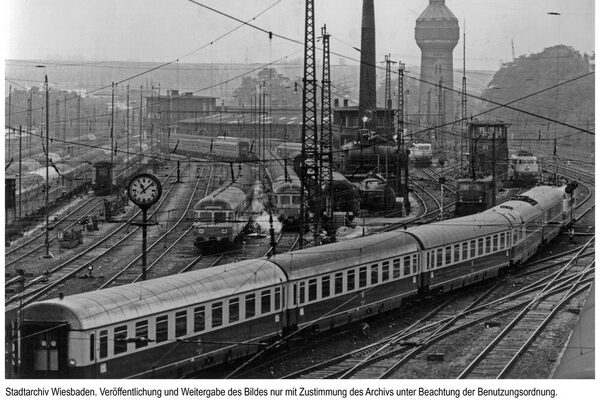Railroad
The private Taunusbahn railroad marked the beginning of the railroad age for Wiesbaden in 1839/40. It ran from Frankfurt am Main via Höchst and Kastel to Wiesbaden with a branch line from the "Curve" station (today's Wiesbaden Ost station) to Biebrich. At the time, the line touched the Free City of Frankfurt, the Duchy of Nassau and the Grand Duchy of Hesse-Darmstadt at Kastel. While Nassau wanted a connection between its capital and the commercial and financial metropolis on the Main, Frankfurt wanted a connection to the port of Biebrich in order to maintain a connection to the Rhine that was independent of Mainz. This was precisely what Hesse-Darmstadt sought to avoid in consideration of Mainz. In a compromise, it allowed the Taunusbahn line to run via Kastel, but Biebrich was only connected by a less efficient horse-drawn railroad. Frankfurt's expectations had thus been successfully thwarted, without being able to dispel the reservations in Mainz about the railroad on the right bank of the Rhine and its negative impact on Mainz's port function.
In 1871/72, the highly profitable Taunusbahn was purchased by the Hessian Ludwigsbahn and sold on to the Kingdom of Prussia. Although this meant that the Biebrich branch line switched from horse-drawn traction to steam operation, it did not enhance its value in the long term. It was closed in 1907 and replaced by a freight-only line to the "new" Rheinbahnhof, which no longer exists today. The initially private right-hand Rhine line from Rüdesheim via Eltville to Wiesbaden provided the town with its second rail link in 1856/57. In 1859-63, the Duchy built the Lahntalbahn Wetzlar-Oberlahnstein and the right-hand Rhine line Oberlahnstein-Rüdesheim. After a short connecting section was built near Biebrich in 1862 between the "Curve" station of the Taunusbahn and the right-hand section of the Rhine, the Nassau state railroad network had reached its final extent. As early as 1864, the connection between Koblenz and Oberlahnstein established the link between the right bank of the Rhine and the Lahntalbahn towards Bonn and Cologne. The continuous connection on the right bank of the Rhine between Cologne and Wiesbaden was only established at the time of the foundation of the German Reich in 1871 with the completion of the Deutz-Niederlahnstein line.
The line from Wiesbaden to Niedernhausen, which opened in 1879, established the connection to the Main-Lahn-Bahn from Limburg via Idstein to Höchst and created the first direct connection between Limburg and Wiesbaden. Both the Main-Lahn Railway and the Niedernhausen-Wiesbaden branch line were built and operated by the Hessische Ludwigsbahn. After the takeover of the Nassau state railroad in 1866 and the nationalization of the Hessische Ludwigsbahn in 1896/97, Prussia was the sole operator of railroads in Wiesbaden. The Langenschwalbacher Bahn was opened in 1889.
The commissioning of the Mainz bypass line from Bischofsheim to Mombach in 1904 with the Kaiserbrücke bridge finally provided Wiesbaden with a rail link to Mainz. Inextricably linked to this was a functional restructuring of the railroad facilities in the western Rhine-Main region, which still exists today. The generously designed Wiesbaden main station (1906) now relieved the main station in Mainz, which had limited capacity. In 1960/61, electric operation began from Wiesbaden in the direction of Oberlahnstein, Mainz and Frankfurt.
In 2002, the high-speed line from Cologne to Frankfurt was opened with a branch line to Wiesbaden. Wiesbaden's hopes of being able to participate in high-level long-distance rail passenger transport were not fulfilled. The role of the railroad for Wiesbaden is therefore ambivalent in the present: although Wiesbaden is largely cut off from long-distance passenger transport, the standard of local and regional passenger transport is very high. Freight transport by rail in the Wiesbaden city area essentially only serves large-scale industry on the Rhine in Biebrich and Amöneburg. The high relevance of the right-hand Rhine route for national and international through freight traffic has no practical benefit for Wiesbaden.
Literature
Hager, Bernhard: "Sucked up by Prussia" or a "boon for Hesse"? The Prussian-Hessian railroad community of 1896/97. In: "On iron rails, as fast as lightning". Regional and supra-regional aspects of railroad history (Schriften des Hessischen Staatsarchivs Marburg, vol. 19), Marburg 2008 [pp. 81-111].
Hager, Bernhard: The transition to the state railway system in the Duchy of Nassau. In: Nassauische Annalen 120/2009 [pp. 393-411].
